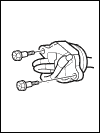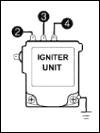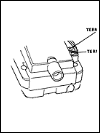
|

|

|

|
Fuel System |
Ignition System |
Statistics
|
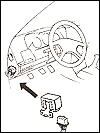
Where is the main relay located on the Accord? |
|||||||||||||||||||||||||||||||
ALERT UPDATE: 90-93 Accord owner may expect sudden failure of the igniter, coil, main relay, and/or possibly the distributor rotor, all due to their age. The igniter and distributor rotor are the most common failure and are dangerous because they may stall in traffic and won't restart. It's highly recommended that you replace your igniter, coil, main relay, and the distributor rotor. Especially, if your ignitor brand is "OKI."
-(9/01/14)
ALERT UPDATE: For 15+ year old cars. Replace the plastic radiator as soon as possible if you find any indications of a hairline crack on the plastic part of the radiator. Sometimes you may notice white spots on the plastic radiator. Sometime coolant is seen weeping from out of nowhere. Sometimes nothing is seen. Always consider an all metal radiator as a replacement.
-(9/01/14)
ALERT UPDATE: Inspect your tire for age. Tires older than possibly 6 or 7 years may rupture while driving. You may loose control and crash from a single tire ripping apart. A tragedy can be prevented only by you.
Miscellaneous info: While driving, if you feel your car tire making noises or show poor handling for just a fraction of second, something may be wrong.
-(9/01/14)
Overview
Why doesn't my Honda or Acura start sometimes? The main relay is famous for stranding people for a few minutes usually in a parking lot in hot weather. The problem is so common that it's been coined the "petrol station fuel relay" from fuel station attendants. The technical name for the main relay is PGM-EFI Main Relay Assembly. PGM stands for programmed, EFI stands for Electronic Fuel Injection.
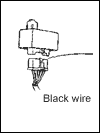 Main relay symptoms are:
Main relay symptoms are:
- Car won't start when
hot outside (fuel injected PGM-FI models
only. For carb see
 )
) - Car won't start after parked for just a minute.
- Car starts but quickly dies as the rpm shoots to 1300 rpm. A second cranking attempt will crank but no signs of catching or any strong rpm movements.
- Once started the car won't stall. After the car runs for a couple minutes, the symptoms return after shutting off the engine.
- Windows have been rolled up on a hot day when problem occurred.
- The heater was on before turning the car off.
- Tapping your fingers or keys on the main relay will start the car.
- No (humming) sound from the fuel pump the moment the ignition switches ON.
- No click sound after the ignition key turns on or
- No click sound two seconds after the ignition turns on.
- Check engine light comes on (rare cases) or stays on longer than usual and no sparks (electronic timing only.)
- 10-15 of waiting and the car pushed to a shade, will usually start.
- If this is your car, see Solutions.

Other common and important electrical problems such as the distributor, ignition switch, fuel pump, transmission and the cooling system circuit are examined on this site. You've come to the right place for an in debt look into the most common electrical problems that you may be able to do the repairs by yourself and get back on the road again. Since the main relay is the most reported problem more attention has been dedicated to the main relay. Choose your symptoms on this page and follow the link destinations or use the top left navigation to known common problems.
- The dash will go dark when it dies (no warning lights, no shift indicator, no electrical).
- Car stalls then can be started, then stalls after driving or idling for a few seconds or minutes.
- Car runs fine when the key slightly held at start position or part way between start and ON position. In rare cases, this symptom is similar to a bad main relay.
- Ignition (electrical) switch is hot.
- See Ignition Switch page
 for details.
for details.
- The tachometer quits abruptly or jerks around before stalling.
- The car quits abruptly or jerks around before stalling.
- Engine cools down and starts, stalls under normal operating temperature.
- Oki igniter brand was installed.
- No spark at the coil.
- All dash warning lights shows up during stalling.
- See Ignition
System
 for details.
for details.
- No spark at the coil.
- Cranking shows no signs of sputtering.
- The RPM needle shows an immeasurable hint of life.
- Car won't start the next day and from then on.
- The distributor was abused before it died.
- The coil looks extremely dry, melted, flaking or cracking.
- All dash warning lights shows up during stalling.
- See Ignition
System
 for details.
for details.
 Fuel pump: Symptoms of a bad fuel pump.
Fuel pump: Symptoms of a bad fuel pump.
- Turn the ignition switch on and no hum is heard for the first 2 seconds.
- Car stalls while idling or cruising above 1 mph. Sometimes car comes back to life.
- To troubleshoot or replace the fuel pump see this page.
 Flooding:
Flooding:
- Spark is found and can smell gas.
- Engine will crank but with no signs of sputtering but may sputter on one or two cylinders.
- Once started, a plume of smoke is seen from the tailpipe and idles rough before settling into a smooth idle.
- After being able to start the car will restart just fine.
- Press the gas halfway or fully down to release fuel vapor and allow more air to balance the air/fuel ratio usually starts.
- Some late model cars have the ability to shut off the injectors for a number of seconds when starting at full throttle. This clears the combustion chamber. Check your owner's manual.
- Engine cranks but won't start when it rains.
- Signs of moisture on the ignition wire.
- Shutoff the car and come back a couple hours later will start.
- see humid.html for details.

 Bad starter
solenoid, dirty console, clutch switch:
Bad starter
solenoid, dirty console, clutch switch:
- Will only click at the starter solenoid but won't crank (motor/starter won't spin.)
-
Click here to troubleshoot starter related problems.

 Corroded
battery terminals, bad ground straps, bad battery or alternator charging symptoms are:
Corroded
battery terminals, bad ground straps, bad battery or alternator charging symptoms are:
- Engine does not turn over or turns over very slowly then quits.
- Sometimes the dash will go dark or dim when attempting to start (no warning lights, no shift indicator, no electrical).
- Usually a single snap is heard from the battery post when attempting to start followed by no relay clicks, warning lights, no electrical.
- Usually a jump start form another car will start the car is an indication of a draining battery, bad alternator or battery. The voltage should be 14 - 14.4V at 2000-rpm.
 TW
(coolant temperature) sensor:
TW
(coolant temperature) sensor:
- Won't start when cold outside or on a cold engine.
- Disconnecting the TW sensor usually starts.
- No spark and check engine light is on and stays on. Learn
more

 Low
compression:
Low
compression:
- Won't start when stored for a month or so.
- Car just overheated and quits on its own.
- Compression reads low. (normally 100-180-psi should start)
- Pouring a cap of motor oil into the cylinder usually starts. (Don't attempt if not certain.)
- This is not categorized as intermittent.
 A
basic starting troubleshooting flowchart can be found in two locations.
A
basic starting troubleshooting flowchart can be found in two locations.
ignition.html#flowchart
mainrelay.html#Troubleshoot
For more Honda help you may try external sites

